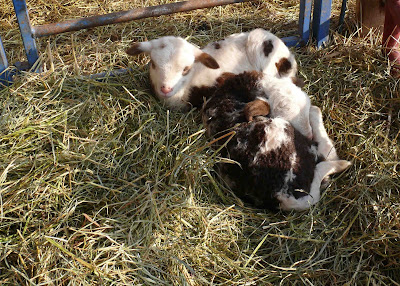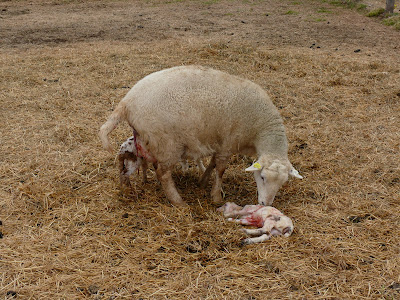Oftentimes, our customers will ask in frustration what they can do to help change our seriously warped industrial agriculture system. It can be overwhelming because its become such a big problem. It can be hard to know where to start.
The good news is there is a lot than can be done and it all begins at the beginning! Many changes begin in small ways and are easily implemented even when working hard as a busy parent, homemaker or worker bee.
First of all, every time you buy something locally produced at a farmers' market or local coop, your dollars are making a statement, sending a message to producers, and removing one animal from an inhumane feedlot operation.
This is probably the one most important thing you can do and has a profound and rippling affect down throughout the ag system.
By supporting producers doing the right thing, you strengthen them and make it easier for them to compete, increase their production and continue to spread the good word.
Which leads me to my next item, which is education. I consider this probably the most important thing because every time I can get someone thinking about food and its provenance, I create a lifelong catalyst for change. There are too many people who are ignorant and blissful.
Now don't get me wrong, I love a little ignorant bliss as much as the next person, but some things are too important to ignore. Food and its provenance is one of those things. The costs are just too high for our health, the health of the environment, our local farming community and the misuse of public funds (i.e. your money) to support a pathologic system of food production.
When you buy food from retailers like BJ's or COSTCO, you directly support the mistreatment of animals, the ruining of our physical environment, the exploitation of workers in very powerless situations, and serious effects on human health.
As a parent, are you concerned about your family's well-being? What are the long-term ramifications of your spending habits. What about your children's lives? Are your habits making the world a better place for them when they reach adulthood and are looking to have their own families?
If you're a religious person, should you treat the world around you as a treasure or something to be exploited, used up and then discarded? Animals, plants and the world we live in deserve to be treated with respect and kindness.
I've heard that American Indian traditions require that any new practice be judged as to its affect several generations or more down the line, before they are considered just or permissable.
Just because the Chinese are willing to make the same mistakes we made in terms of their environmental protection doesn't mean we shouldn't care or that we should support their bad decisions just because its cheap. Much of what we eat is now coming out of China and other essentially unregulated sources.
We now have melamine in our food supply in THIS country because of our careless policies that emphasize cheap food above all else. And dust storms now blow across the continents from Africa and Asia and significantly (and usually negatively) affect weather in North America.
Okay, enough preaching. Sorry but this is something I feel just can't wait. I am most certainly an idealist at heart.
Here are some very concrete suggestions you might want to explore:
1. Join a CSA.
This is a great way to get hooked up to the local food production community and get the freshest, best things that local farmers have to offer. Not all CSA's are the same and you should look around for a CSA that best suits your needs in terms of delivery, the kinds of products included (just veggies, milk products, meats, year-round, costs, etc).
I think we may be launching our first CSA's next fall and will target Frederick, Maryland for easy delivery. Hopefully, we can expand to D.C. if all goes as planned in 2010.
2. Check out some really great films out now and consider showing them locally:

3. Frequent your local farmers' markets, get to know your farmers and talk to them. Ask them about barriers to delivering their products to market.
Oftentimes, there are simple things that can be done to remove barriers to local food delivery. A good example here in Maryland were existing state laws that prevented farmers from selling poultry processed on-farm to consumers at farmers' markets. We could sell you a chicken on the farm, but not at the local farmers' market.
Arbitrary and unnecessary legislation harking back to a time when off-farm poultry processing was readily available to local farmers. This is no longer the case as small abbatoirs have struggled to compete with super cheap meats.
Maryland Dep't of Ag recently created a new program to certify farmers to process their own poultry for resale to consumers at farmers' markets directly. This still doesn't solve the problem of other retail outlets unavailable to local farmers, like your family supermarket, but we often measure change in small steps.
4. Explore some online resources specifically geared towards connecting consumers with local producers. Many have email alerts that can help you keep current on legislation affecting the local foods movement in your area.
Here are just a few:
SLOW food USA - awesome global organization that promotes local food. They have a yearly conference in Italy every year! Italy anyone!
LOCAL HARVEST - good resource for finding local producers and local farming/consumer events.
Farm-to-Consumer Legal Defense Fund http://www.ftcldf.org/ - helps counteract some of the unfair practices affecting small producers and their access to consumers. helps counteract some of the oppressive bureaucratic oversight and powerful big-ag lobby.
EAT WILD! - a good resource for finding grass-fed, finished operations in your area. grass fed meats have been shown to have the same health benefits as fish oil in terms of high levels of omega-3 fatty acids.
100 mile diet Try eating only locally produced (within 100 miles) food for a month or a year. Don't worry, you're allowed a few luxury items like coffee, tea, OJ, etc!
I'll stop there but this is just a beginning! Please don't be offended by what I have to say - this is my opinion. Educate yourself and then get back to me as to whether I was off-base or not ;)
A word of warning however...this is a slippery slope. Once you start to educate yourself, you can't easily turn back to that blissful place and you will never look at what and how you eat the same way again :)
K





























